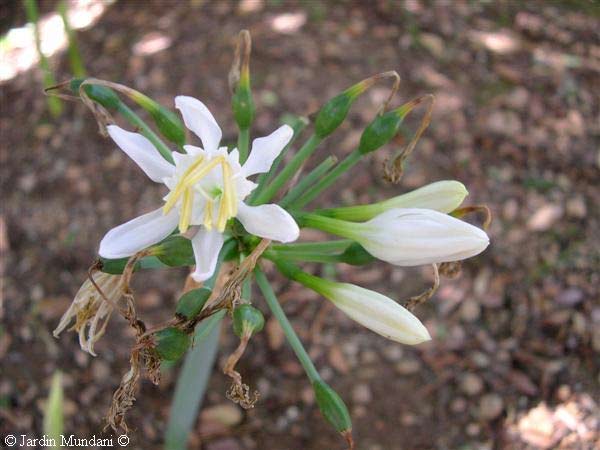
Pancratium canariense (*)
Classification System: APG IV
Superregnum: Eukaryota
Regnum: Plantae
Cladus: Angiosperms
Cladus: Monocots
Ordo: Asparagales
Familia: Amaryllidaceae
Subfamilia: Amaryllidoideae
Tribus: Pancratieae
Genus: Pancratium
Species: Pancratium canariense
Name
Pancratium canariense Ker Gawl., Bot. Reg. 2: t. 174. 1817.
Synonyms
Homotypic
Bollaea canariensis (Ker Gawl.) Parl., Bull. Soc. Bot. France 5: 509. 1858.
Heterotypic
Pancratium teneriffae Willd. ex Schult. & Schult.f. in J.J.Roemer & J.A.Schultes, Syst. Veg. 7: 925. 1830.
Distribution
Native distribution areas:
Continental: Africa
Regional: Macaronesia
Canary Islands (Gran Canaria, Gomera, Hierro, La Palma, Tenerife, Fuerteventura, Lanzarote)
References: Brummitt, R.K. 2001. TDWG – World Geographical Scheme for Recording Plant Distributions, 2nd Edition
References
Ker Gawler, J.B. 1817. Botanical Register; Consisting of Coloured Figures of Exotic Plants Cultivated in British Gardens; with their History and Mode of Treatment. London 2: t. 174.
Links
Govaerts, R. et al. 2018. Pancratium canariense in World Checklist of Selected Plant Families. The Board of Trustees of the Royal Botanic Gardens, Kew. Published on the internet. Accessed: 2018 Aug. 06. Reference page.
International Plant Names Index. 2018. Pancratium canariense. Published online. Accessed: Aug. 06 2018.
USDA, ARS, Germplasm Resources Information Network. Pancratium canariense in the Germplasm Resources Information Network (GRIN), U.S. Department of Agriculture Agricultural Research Service. Accessed: 07-Oct-06.
Vernacular names
English: Canary Sea Daffodil
svenska: Kanarisk strandlilja
Pancratium canariense or the Canary Sea Daffodil is a species of bulbous plant endemic to the Canary Islands. It grows on north facing slopes in good light, not exposed to hot burning sun and not baking drought. It grows in fertile soil between rocks and shrubs. It flowers in the early autumn. The name canariense mean "from the Canary Islands".
Description
Bulbous perennial with glaucous leaves. It forms quite large bulbs (12–15 cm diameter) with a short neck. The plant is winter growing and summer dormant. Scape to 80 cm. Flowers in a multiflowered umbel, white with a corona. Very fragrant. Flowers in the fall. Pancratium illyricum from southern Europe is very similar. It has narrower leaves, shorter flower-stalks and flowers in the spring.
Photo: Juan Bibiloni
Cultivation
Easy to grow and flowers freely if planted in a sunny spot. It does not tolerate frost, but should be very good for coastal Californian gardens in the fog belt. Hardy to USDA zone 10.
References
Walters, S.M. The European Garden Flora, Vol. 1. Pteridophyta; Gymnospermae; Angiospermae—Alismataceae to Iridaceae. ISBN 0-521-24859-0
Retrieved from "http://en.wikipedia.org/"
All text is available under the terms of the GNU Free Documentation License

